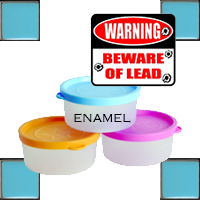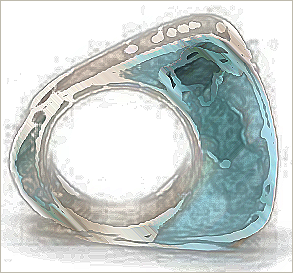
Leaded Enamels: Quick Info and Resources
![]() If you are an enamelist or familiar with enameling on jewelry, you’ve probably heard talk of leaded (or lead-bearing) versus un-leaded enamels. Both leaded and un-leaded enamels have their uses and can even be used together when done properly. Since leaded enamels have not been produced in the United States since about 1990, you can only purchase those made in other countries, such as Japan and France, through a U.S. distributor (see sources below).
If you are an enamelist or familiar with enameling on jewelry, you’ve probably heard talk of leaded (or lead-bearing) versus un-leaded enamels. Both leaded and un-leaded enamels have their uses and can even be used together when done properly. Since leaded enamels have not been produced in the United States since about 1990, you can only purchase those made in other countries, such as Japan and France, through a U.S. distributor (see sources below).
Personally, I love the transparent leaded enamels from Japan, as I find the color options larger and the brilliance and depth of the final product stunning (I swoon over the blue hues). I haven’t worked much with opaque enamel colors, but take a gander at the awesome vintage colors available at e-namels.com. They made the yeoman’s effort to photograph actual samples that come close to showing you what the yummy colors actually look like, even on a computer screen. I’ve also read rave reviews of Soyer leaded enamels, made in France, but I haven’t personally used them.
Unsurprisingly, the first concern in using leaded enamels is safety, for obvious reasons. However, if you set up proper ventilation in your studio and use proper safety protection (such as a particulate mask), there is no need to fear working with the leaded variety. Charles Lewton-Brain has a nice piece, Enameling Safety Issues (The Ganoksin Project), which will appeal to you science buffs who want to know some of the down and dirty chemical details.
No matter what type of enamel you use, it is well worth the trouble to create an enamel color board. This is a a board that is sturdy enough to take small nails from which you hang small metal samples showing what the various enamel colors actually look like after firing. I have a board of transparent samples where a piece of copper is enameled such that you see a swatch of enamel directly on the copper, a swatch over white and a swatch over silver foil. I know it sounds tedious, but the reward is in the beautiful, quick reference you have created for yourself.
Some enameling resources:
- Book: The Art of Enameling: Techniques, Projects, Inspiration, by Linda Darty. LOVE this book.
- Lead-bearing Enamel Suppliers:
- Enamelworks Supply — they carry the Ninomya Japanese enamels that I have used
- E-namels.com, “The world’s leading supplier of vintage enamel”
- Schlaifer’s Enameling Supplies LLC — you can buy Soyer enamels here
- General supplier of tools and materials:
- Dick Blick — enameling supply section; they have a nice price on the Paragon SC2 kiln
- Warg Enamel and Tool Center — if you live on the East Coast, you should also consider taking one of Pauline Warg’s enameling classes in Maine; she, her class and her studio are all delightful!
- Rio Grande — general supplies
- Clay-King — kilns
- Jewelry DIY’s Enameling Image Gallery on Pinterest





